Videos, clinical notes and related presentations concerning neuro-ophthalmological and neurovisual disorders collected during Dr. Wray's work as the Director of Neuro-Visual Disorders at Massachusetts General Hospital.
Shirley H. Wray, M.D., Ph.D., FRCP, Professor of Neurology Harvard Medical School, Director, Unit for Neurovisual Disorders, Massachusetts General Hospital.
NOVEL: https://novel.utah.edu/
TO
Filters: Collection: "ehsl_novel_shw"
| Title | History | Type | ||
|---|---|---|---|---|
| 1 |
 |
Congenital Nystagmus | This young boy has oculocutaneous albinism. In 1979 he presented for evaluation of oscillations of his eyes present since birth. He had no head turn or head tremor. Diagnosis: Albinism Congenital sensory nystagmus Ocular Albinism: Infants with albinism of all types are typically slow to see, ofte... | Image/MovingImage |
| 2 |
 |
Pseudo-Internculear Ophthalmoplegia | This 32 year old man had the acute onset of double vision followed very quickly by a drooping of the left eyelid. Past History: Negative for any previous episode of double vision No history of strabismus as a child No fatigue, neck weakness, difficulty in chewing or swallowing Family History: Neg... | Image/MovingImage |
| 3 |
 |
Retinal Emboli | Temporary loss of vision in one eye, termed transient monocular blindness (TMB), is the most important visual symptom of arteriosclerotic vascular disease, arteritis and states of altered coagulability and thrombocytosis. In most patients, the visual disturbance during each individual attack of ... | Image/MovingImage |
| 4 |
 |
Third Nerve Palsy | The patient is a 50 year old man with Type II Diabetes who presented to an outside hospital in September 1996 with ptosis and an inability to open the right eye. Five months prior to admission (PTA), he had flu-like symptoms with mild fever, sinus congestion and diffuse myalgia in the chest, abdo... | Text |
| 5 |
 |
Opsoclonus in The Dark | N/A | Image/MovingImage |
| 6 |
 |
Supranuclear Paralysis of Upgaze | The patient is a 32 year old man who was admitted as an emergency with severe headache and papilledema. On examination he had signs of the Pretectal Syndrome. • Bilateral lid retraction in primary gaze - Collier's sign • Supranuclear paralysis of upgaze (saccades and pursuit) • Full horizon... | Image/MovingImage |
| 7 |
 |
Bilateral Sixth Nerve Palsy | The patient is a 60 year old woman who consulted her ophthalmologist with a chief complaint of double vision looking to the left. He diagnosed of a left sixth nerve palsy. No investigations were done. Two years later she complained of diplopia looking to the right. A diagnosis of bilateral six... | Image/MovingImage |
| 8 |
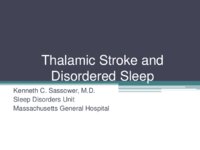 |
Thalamic Stroke and Disordered Sleep (Guest Lecture) | Text | |
| 9 |
 |
Migraine / PET Study | In December 1994 the New England Journal of Medicine published a remarkable paper Bilateral Spreading Cerebral Hypoperfusion during Spontaneous Migraine Headache. Roger P. Woods, Marco Iacoboni and John C. Mazziotta. which is reproduced in part, and accompanied by a video illustration. Courtesy of J... | Image/MovingImage |
| 10 |
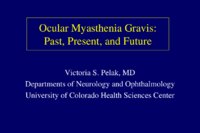 |
Ocular Myasthenia Gravis (Guest Lecture) | Text | |
| 11 |
 |
Parkinson's Disease (Guest Lecture) | Text | |
| 12 |
 |
Brain MRI in Multiple Sclerosis (Guest Lecture) | Text | |
| 13 |
 |
Alcoholic Cerebellar Degeneration | The patient is a 72 year old woman who presented with a 4 year history of progressive difficulty with balance, frequent falls and unsteadiness walking. She required a cane to steady herself. Past History: Significant for alcohol abuse. In 1980, she came to Boston for a second opinion and was seen... | Text |
| 14 |
 |
Alexia Without Agraphia | The patient is a 69 year old left handed man with a history of hypertension, insulin dependent diabetes mellitus and atrial fibrillation. Treated with coumadin, adjusted to keep the INR between 2 and 3. On the morning of admission he awoke at 4 a.m., sat momentarily on the side of the bed and then... | Text |
| 15 |
 |
Alzheimers Disease | The patient is a 78 year old left handed woman with a diagnosis of a left parietal infarct in 1995, bilateral carotid artery stenosis and hypertension. She was first seen in August 1997 for evaluation of involuntary movements of the lower face in the setting of rapidly progressive dementia and was... | Text |
| 16 |
 |
Eyebrow Spasm (Guest Lecture) | This case is published courtesy of Daniel J. Costello, M.D., Department of Neurology, Massachusetts General Hospital, Boston. The patient is a 32-year-old right-handed man with an established diagnosis of Tuberous Sclerosis Complex characterized by: - medically intractable epilepsy - developmental... | Text |
| 17 |
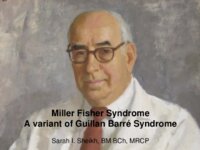 |
Miller Fisher Syndrome (Guest Lecture) | Text | |
| 18 |
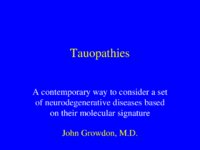 |
Tauopathies (Guest Lecture) | A contemporary way to consider a set of neurodegenerative diseases based on their molecular signature. | Text |
| 19 |
 |
Chest CT Thymoma (Guest Lecture) | Text | |
| 20 |
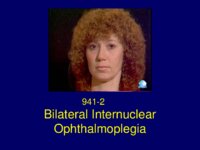 |
Bilateral Internuclear Ophthalmoplegia | This patient was seen at the Yale Eye Center at the age of 37. She had a long history of multiple sclerosis. At age 22, she had an acute attack of optic neuritis in the left eye which recovered fully within three weeks. Some months later she had a recurrent episode in the same eye, which also ... | Text |
| 21 |
 |
Bilateral Ptosis | This case, previously reported in 2007, is published courtesy of John Newsom-Davis, M.D., FRCP, FRS, CBE. Weatherall Institute of Molecular Medicine, John Radcliffe Hospital, Oxford. This patient was unusual in presenting in early childhood and the development of persistent facial muscle and tongue... | Text |
| 22 |
 |
Blepharospasm Round Up (Guest Lecture) | Text | |
| 23 |
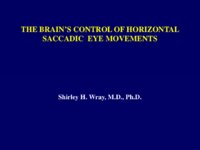 |
Brain Control of Horizontal Saccadic Eye Movements (Guest Lecture) | Text | |
| 24 |
 |
Brainstem Cavernous Angioma | The patient is a 50 year old woman who presented in November 1977 with a transient facial droop, nystagmus, diplopia, dysarthria and vertigo. She was admitted to New England Tufts Medical Center and had an extensive workup including an electroencephalogram, first generation CT brain scan, angiogram ... | Text |
| 25 |
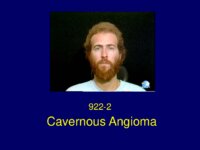 |
Cavernous Angioma | The patient is a 19 year old sophomore who presented in 1983 with numbness of the left hand, involving initially just the fingers, and numbness and weakness of the right side of the face. He described the numbness in his hand as if it was "intensely asleep". The facial numbness involved the peri... | Text |
